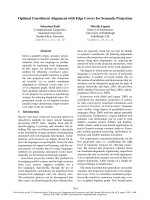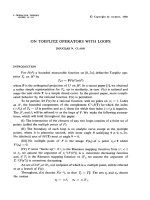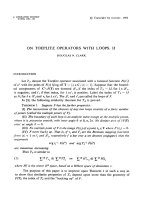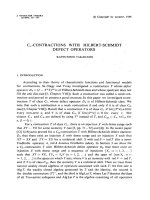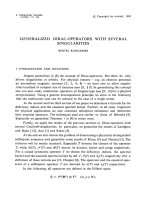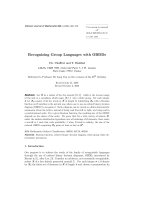Báo cáo toán học: "Optimal double-loop networks with non-unit steps" pptx
Bạn đang xem bản rút gọn của tài liệu. Xem và tải ngay bản đầy đủ của tài liệu tại đây (142.43 KB, 13 trang )
Optimal double-loop networks with non-unit steps
∗
F. Aguil´o, E. Sim´o and M. Zaragoz´a
Dept. de Matem`atica Aplicada IV
Universitat Polit`ecnica de Catalunya
C/. Jordi Girona 1-3
08034 Barcelona, Spain.
Submitted: Apr 1, 2002; Accepted: Dec 19, 2002; Published: Jan 6, 2003
MR Subject Classifications: 05C20, 05C12, 05C85, 68M10.
Abstract
A double-loop digraph G(N; s
1
,s
2
)=G(V,E) is defined by V = Z
N
and
E = {(i, i + s
1
), (i, i + s
2
)| i ∈ V },forsomefixedsteps 1 ≤ s
1
<s
2
<Nwith
gcd(N, s
1
,s
2
)=1. LetD(N; s
1
,s
2
) be the diameter of G and let us define
D(N)= min
1≤s
1
<s
2
<N,
gcd(N,s
1
,s
2
)=1
D(N; s
1
,s
2
),D
1
(N)= min
1<s<N
D(N;1,s).
Some early works about the diameter of these digraphs studied the minimization of
D(N;1,s), for a fixed value N,with1<s<N. Although the identity D(N)=
D
1
(N) holds for infinite values of N , there are also another infinite set of integers
with D(N) <D
1
(N). These other integral values of N are called non-unit step
integers or nus integers.
In this work we give a characterization of nus integers and a method for finding
infinite families of nus integers is developed. Also the tight nus integers are classified.
As a consequence of these results, some errata and some flaws in the bibliography
are corrected.
Keywords: Diameter, double-loop network, nus integer, optimal family, L-shaped tile,
Smith normal form.
∗
Work supported by the Ministry of Science and Technology, Spain, and the European Regional
Development Fund (ERDF) under project TIC-2001 2171 and by the Catalan Research Council under
project 2000SGR00079.
the electronic journal of combinatorics 10 (2003), #R2 1
1 Notation and preliminary results
Double-loop digraphs G = G(N; s
1
,s
2
), with 1 ≤ s
1
<s
2
<Nand gcd(N,s
1
,s
2
)=1,
have the vertex set V = Z
N
and the adjacencies are defined by v → v + s
i
(mod N) for
v ∈ V and i =1, 2. The hops s
1
and s
2
between vertices are called steps.
These kind of digraphs have been widely studied to modelize some local area networks,
known as double-loop networks (DLN.) From the metric point of view, the minimization
of the diameter of G corresponds to a faster transmission of messages in the network.
The diameter of G is denoted by D(N; s
1
,s
2
). As G is vertex symmetric, its diameter can
be computed from the expression max
i∈V
d(0,i), where d(u, v) is the distance from u to
v in G.ForafixedN ∈ N, the optimal value of the diameter is denoted by
D(N)= min
1≤s
1
<s
2
<N,
gcd(N,s
1
,s
2
)=1
D(N; s
1
,s
2
).
Several works studied the minimization of the diameter (for a fixed N)withs
1
=1. Let
us denote D
1
(N)=min
1<s<N
D(N;1,s). Since the work of Wong and Coppersmith [7],
a sharp lower bound is known for D
1
(N):
D
1
(N) ≥
√
3N
− 2=lb(N).
Fiol et al. in [5] showed that lb(N) is also a sharp lower bound for D(N). A given
double-loop G(N; s
1
,s
2
) is called k-tight if D(N; s
1
,s
2
)=lb(N)+k.Ak-tight DLN is
called optimal if D(N )=lb(N)+k. The 0-tight DLN are known as tight ones and they
are also optimal. A full classification of tight and k-tight DLN can be found in [4] and
[1], respectively.
The metrical properties of G(N; s
1
,s
2
) are fully contained in its related L-shaped tile
L(l, h, w, y)withareaN = lh − wy. This tile can be obtained from G with the following
procedure:
1. In the squared plane, label each square with a number in {0, 1, 2, , N − 1} using
the rules in the left side of Figure 1. All the additions must be taken modulus N.
2. Take any square labelled with ‘0’. Associate to this square the squares with labels
in {1, 2, , N − 1} at minimum distance from ‘0’ in the digraph G.Takealexi-
cographic order if necessary. The right side of Figure 1 shows the linked tile (and
the tessellation it defines) to the digraph G(7; 2, 3). The linked tile of G(7; 2, 3) has
dimensions l = h =3,w =1andy =2.
It is always possible to form an L-shaped tile proceeding in this way [5, 7]. It is said that
the tile L can be (s
1
,s
2
)-implemented. Note that Chen and Hwang in [3] proposed the
following necessary and sufficient conditions for a tile with area N:
Theorem 1 There exists G(N; s
1
,s
2
) realizing the L-shape (l, h, w, y) iff l>y, h ≥ w
and gcd(l, h, w, y)=1.
the electronic journal of combinatorics 10 (2003), #R2 2
s
1
2s
1
s
2
2s
2
s
1
+ s
2
0
0
0
0
0
0
0
0
0
3s
1
3s
2
s
1
+2s
2
2s
1
+ s
2
1
1
1
1
1
1
1
1
2
2
2
2
2
2
2
2
3
3
3
3
3
3
3
3
4
4
4
4
4
4
4
4
5
5
5
5
5
5
5
5
6
6
6
6
6
6
6
6
Figure 1: Interconnection rules from a generic digraph G(N; s
1
,s
2
) and the related tile to
G(7; 2, 3)
l
h
w
y
(−w, h)
(l, −y)
Figure 2: Generic dimensions of an L-shaped tile and its related tessellation.
Figure 2 describes how we denote the dimensions of a generic L-shaped tile and how
the resulting tiling of the plane can be fully described from the integral matrix M =
l −w
−yh
, whose entries are the (column) vectors u =(l, −y)
and v =(−w, h)
.In
particular, the diameter’s computation of G can be done from the dimensions L(l, h, w, y)
by
d(L)=d(L(l, h, w, y)) = max{l + h − w −2,l+ h − y − 2}. (1)
For obvious reasons, the value d(L) is called the diameter of the tile L.Itcanbeshown
that D(N; s
1
,s
2
) ≤ d(L)ifL is any linked tile to G(N; s
1
,s
2
). Several tiles can be related
to a given digraph G (possibly with different diameters,) however the tile generated by
the previous procedure has the same diameter as G. In particular, when d(L)=lb(N)
we have d(L)=D(N; s
1
,s
2
)=D(N ).
the electronic journal of combinatorics 10 (2003), #R2 3
Definition 1 (Isomorphism of digraphs) Two digraphs, G
1
(V
1
,E
1
) and G
2
(V
2
,E
2
),
are isomorphic if there is a bijective map φ : V
1
→ V
2
which preserves adjacencies, that is
(u, v) ∈ E
1
iff (φ(u),φ(v)) ∈ E
2
. Two isomorphic digraphs will be denoted by G
1
∼
=
G
2
.
As an immediate example of double-loop digraph isomorphism, we have G(N; s
1
,s
2
)
∼
=
G(N; s
2
,s
1
) by the group isomorphism φ : Z
N
→ Z
N
given by φ(s
1
)=s
2
and φ(s
2
)=s
1
(provided that gcd(N, s
1
,s
2
) = 1.) Note that we have the adjacency (u, v)inG(N; s
1
,s
2
)
if and only if we have also the adjacency (φ(u),φ(v)) in G(N; s
2
,s
1
). We will call this
isomorphism the direct isomorphism.
L-shaped tiles have been used as a metric tool to minimize the diameter of this kind of
digraphs. Not only we can link an L-shaped tile to a given digraph G, but also we can
recover the original digraph (or an isomorphical one) from its related tile. It is important
to remark that the notation L(l, h, w, y) not only completely describes the tile but also it
gives the tiling which tessellates the plane. See [2, 4] for more details. The computation
of the steps from the matrix M is described in the following proposition (whose proof is
contained in [4].)
Proposition 1 (Steps computation from the dimensions of the tile) Let G be a
double-loop with linked tile L = L(l, h, w, y).LetM be the matrix defining the tiling
related to L,withgcd(l, h, w, y)=1and area N = lh − wy.LetS(M)=diag(1,N)
be the Smith normal form of M, with related unimodular matrices U and V such that
S(M)=UMV . Then the pair of steps s
1
≡ U
2,1
(mod N), s
2
≡ U
2,2
(mod N) defines
G
(N; s
1
,s
2
) which is isomorphic to the original digraph G.
We will use this proposition later on. Two tiles are equivalent if they have the same area
and the same number of nodes at any given distance from the node 0. Two isomorphic
digraphs have equivalent tiles, however two equivalent tiles can correspond to non iso-
morphical digraphs. Note that an isomorphic digraph to G(N; s
1
,s
2
) which is not the
direct one must be of the form G(N; ζs
1
,ζs
2
)withζ ∈ Z
N
= {n ∈ Z
N
:gcd(n, N )=1}
the multiplicative group of unit elements in Z
N
, and their related tiles must be equiva-
lent. Take for instance N = 5 and the related tiles to G(5; 1, 2), G(5; 1, 3) and G(5; 2, 3),
respectively:
41
23 34 3
01 012 024
which are all equivalent ones, however G(5; 2, 3)
∼
=
G(5; 1, 2)
∼
=
G(5; 1, 3). Note that
the digraph isomorphism G(5; 1, 2)
∼
=
G(5; 3, 1) is given by the unit ξ =3;alsowehave
G(5; 3, 1)
∼
=
G(5; 1, 3) by the direct isomorphism, so we have G(5; 1, 2)
∼
=
G(5; 1, 3). There
is no unit η such that (η2,η3) attains (1, 2) nor (2, 1), then G(5; 2, 3)
∼
=
G(5; 1, 2).
Although a great quantity of values of N satisfy the identity D(N)=D
1
(N), there are
infinite values of N without this property. So we give the following definition.
Definition 2 (Nus integer) N ∈ N is a non-unit step (nus) integer if D(N) <D
1
(N).
the electronic journal of combinatorics 10 (2003), #R2 4
N 450 924 930 1050 1764 2058 2415 2814 4224 4686
D(N) 35 51 51 55 71 77 84 91 111 117
s
1
,s
2
2, 185 3, 49 5, 56 2, 51 7, 76 9, 86 5, 77 58, 1437 1431, 2827 75, 3157
D
1
(N) 36 52 52 56 72 78 85 92 112 118
s 59 87 123 196 167 68 140 271 898 301
Table 1: The first ten nus integers
The first published nus integer is N = 450 (found in [5] by computer,) with D(450) =
D(450; 2, 185) = 35 and D
1
(450) = D(N;1, 59) = 36. The first ten nus integers are given
in the Table 1 and have been found by computer search. All of them correspond to tight
digraphs unless N = 2814 which is related to 1-tight optimal digraph. In this paper we
propose a method to find infinite families of tight nus integers, that is integers N with
D
1
(N) >D(N)=lb(N). Note that if N is a nus integer then D(N; s
1
,s
2
) >D(N)if
{s
1
,s
2
}∩Z
N
= ∅.
2 Characterization of nus integers
In order to find a characterization of nus integers, we will use the following results. Some
of them are known yet in the bibliography.
Proposition 2 Let L(l, h, w, y) be an L-shaped tile with area N = lh − wy linked to the
double-loop G(N; s
1
,s
2
). Then the steps s
1
,s
2
satisfy the identity
s
1
s
2
=
hy
wl
α
β
,
for some integral values α and β.
This Proposition was stated first in [5].
Lemma 1 Let f (s, t)=as + bt with a, b ∈ N.Ifg = f (s
0
,t
0
) > 0 is the least positive
value of f over all the integral values s and t, then gcd(a, b)=g.
The proof of this Lemma can be found in many basic texts on Number Theory.
Theorem 2 (Characterization of nus integers) N ∈ N is not a nus integer iff there
is a tile L(l, h, w, y) with area N, l>y, h ≥ w, d(L)=D(N) and gcd(l, w)=1or
gcd(h, y)=1.
Proof:
Suppose there is a such tile L(l, h, w, y)withl>y, h ≥ w, d(L)=D(N)andgcd(l, w)=1
(if gcd(l, w) > 1 and gcd(h, y) = 1, the proof is made by analogy.) Theorem 1 guarantees
that L realizes a double-loop digraph G(N; s
1
,s
2
)withD(N ; s
1
,s
2
)=D(N). Now we
must assure that s
1
=1ors
2
=1. Asgcd(l, w) = 1, there exist integers s, t such that
the electronic journal of combinatorics 10 (2003), #R2 5
sl − tw =1. LetM be the 2 × 2 integral matrix defining the tessellation from the tile
L(l, h, w, y), as it is described in the previous section. Then we have
10
sy − th 1
M
sw
tl
= diag(1,N)=S(M)
and, from the Proposition 1, it follows that D(N; sy − th (mod N), 1) = d(L)=D(N).
Then we have s
1
=1andL is (1,sy − th)-implementable, so D
1
(N)=D(N)andN is
not a nus integer.
Now suppose N a non nus integer. Then D(N)=D
1
(N). Let L(l, h, w, y)withl>y
and h ≥ w be the related tile to the digraph G(N; s, 1) with D(N; s, 1) = D(N). By
Proposition 2, we have
s
1
=
hy
wl
α
β
,
for some α, β ∈ Z.Thenwehaveαw + βl = 1. Now by Lemma 1 it follows that
gcd(l, w)=1.
Theorem 2 characterizes nus integers in the negative sense, the following corollary char-
acterizes them in the positive sense.
Corollary 1 N ∈ N is a nus integer iff for any tile L(l, h, w, y) with area N and d(L)=
D(N), we have
(a) gcd(l, w) > 1 and gcd(h, y) > 1,
(b) the identity gcd(l, h, w, y)=1and inequalities l>yand h ≥ w are fulfilled for one
of these tiles at least.
3 Classification of tight nus integers
The classification of tight nus integers will be done according to their related L-shaped
tiles and it is based on the classification of tight tiles made in [4]. So we follow the
notation used in this reference from now on. Let us denote by x a non negative integer,
then we define I
1
(x)=[3x
2
+1, 3x
2
+2x], I
2
(x)=[3x
2
+2x +1, 3x
2
+4x +1] and
I
3
(x)=[3x
2
+4x +2, 3(x +1)
2
]. As N = ∪
∞
x=0
[3x
2
+1, 3(x +1)
2
], the closed intervals
I
i
(x) i =1, 2, 3 partition the set N for x =0, 1, 2 Moreover lb(N)=3x + i −2ifN ∈ I
i
for i =1, 2, 3.
Following this parameterization, let us denote
N
i,j
(x, a, b)=3x
2
+(2i + j − 3)x + B
i,j
(a, b)(2)
with B
i,j
(a, b)=ab −(a + b −i)(a + b +3−i −j), where i stands for N
i,j
(x, a, b) ∈ I
i
(x)
and, as it is required in [4], x ≥ C
i,j
(a, b)where
C
i,j
(a, b)=
α
i
−B
i,j
(a, b)
j − 1
, with j =1,α
1
= α
2
=1,α
3
=2.
the electronic journal of combinatorics 10 (2003), #R2 6
Obvious restrictions must be added to the values B
i,j
(a, b) in order to assure N
i,j
(x, a, b) ∈
I
i
(x). According to the Table 2 in [4], there are nine different types of tight tiles: each
type is denoted by [i, j] for i, j ∈{1, 2, 3}.
Theorem 3 (Classification of tight nus integers) If N ∈ N is a tight nus integer
then all its related (tight) tiles L(l, h, w, y) with w ≤ y are given by Table 2 with
gcd(a +2b −2i, x − b + i) > 1, (3)
gcd(2a + b +6−2i −2j, x −a + i + j − 3) > 1, (4)
and at least one of these tiles has the parameters x, a, b, i and j =1fulfilling the following
conditions
gcd(a − b, 3a − 2i, x + a + b − i, 3 −j)=1,l>y,h≥ w. (5)
Proof:
If N is a tight nus integer then it corresponds to the nodes of a tight DLN, so D(N)=
lb(N) and all its related (tight) tiles with w ≤ y are given by Table 2 in [4], that is
Table 2 here. By Corollary 1 all these tiles must satisfy (3) and (4) which are equiva-
lent to gcd(l(x, a),w(x, a, b)) > 1 and gcd(h(x, b),y(x, a, b)) > 1, respectively. Also by
Corollary 1, at least one of these tiles must satisfy (5).
According to Table 2 in [4], when j = 1 (that is when N is N
1,1
(x)=3x
2
+1,N
2,1
(x)=
3x
2
+2x +1 or N
3,1
(x)=3x
2
+4x + 2) we will see that at least one of its related tiles
satisfies the Theorem 2 and so its related area, N, can not be a nus integer. Let us see
this property in each of these three types of tiles:
• Type [1, 1]: N
1,1
(x)=3x
2
+ 1 have linked only one tile given by l = h =2x,
w = x − 1andy = x + 1. The expression N
1,1
(x) corresponds to the nodes of a
tight digraph if gcd(l, h, w, y)=1:
gcd(2x, x − 1,x+1)=gcd(x − 1,x+1)=gcd(x −1, 2) = 1 ⇔ x ≡ 0(mod2).
So we must restrict the values of x to x ≡ 0 (mod 2). Then we have
gcd(l, w)=gcd(2x, x − 1) = gcd(2,x− 1) = 1.
• Type [2, 1]: N
2,1
(x)=3x
2
+2x + 1 has several related tiles, one of them is l = h =
2x +1w = x and y = x +2. Then wehave
gcd(l, w)=gcd(2x +1,x)=gcd(1,x)=1.
• Type [3, 1]: One of the tiles related to N
3,1
(x)=3x
2
+4x +2 is L(2x +1, 2x +
2,x,x+2).Alsowehavegcd(l,w)=gcd(2x +1,x)=1.
the electronic journal of combinatorics 10 (2003), #R2 7
N
i,j
(x, a, b) l(x, a) h(x, b) w(x, a, b) y(x, a, b) d(L)
3x
2
+(2i + j − 3)x + B
i,j
(a, b) 2x + a 2x + b x + a + b − i x + a + b +3− i −j 3x + i −2
x ≥ C
i,j
(a, b)
Table 2: Data of a tile linked to a tight nus integer
So N
i,1
(x) does not correspond to a nus integer for each i =1, 2, 3. So the value j =1
must be excluded from the possible options.
Table 2 must be understood with the usual restrictions mentioned above, as well as the
additional restrictions on the integral pairs (a, b) in order to have 0 ≤ w(x, a, b) ≤ l(x, a),
0 ≤ y(x, a, b) ≤ h(x, b), l(x, a) > 0andh(x, b) > 0. Theorem 3 characterizes tiles related
to any tight nus integer. We will use this fact to describe an efficient method to find
infinite families of tight nus integers containing any given value N
0
of such integers.
4 A method to generate infinite families of tight nus
integers
Given a tight nus integer N
0
, we can find all its related tiles with a time cost of O(N
1/2
0
):
• x
0
and i
0
are found in constant time from lb(N
0
)=3x
0
+ i
0
−2,
• then the possible values of j and B
j
= B
i
0
,j
(a, b) are found in constant time also,
• finally, for each value of B
j
all the possible values (a, b) are found in time cost of
O(N
1/2
0
) from the equation ab −(a +b −i
0
)(a +b+3−i
0
−j)=B
j
, which represents
an ellipse. According to the parameterization given in (2) we have B
j
= O(x
0
)and
x
0
= O(
√
N
0
), and so B
j
= O(
√
N
0
). Note that all possible integral points (a, b)
over this ellipse have their coordinates bounded by
2(2i
0
+ j − 3) −
√
∆
6
≤ a, b ≤
2(2i
0
+ j − 3) +
√
∆
6
with ∆ = 16(3 − 2i
0
− j)
2
− 48[B
j
− i
0
(i
0
+ j − 3)]. Then we can search all the
possible integral values of a (and b also) in time cost O(
√
∆). Now from ∆ =
O(B
j
)=O(
√
N
0
), we have that all possible integral points (a, b) over the ellipse
can be searched in time cost O(
√
∆)O(
√
∆) = O(∆) = O(
√
N
0
).
In order to find an infinite family of nus integers containing the above given N
0
,wemust
guarantee the following steps:
(a) Select the tiles satisfying (5) of Theorem 3.
(b) Find a subfamily, N(λ)=N(x(λ)), such that all the tiles found in (a) satisfy (3)
and (4) for these values of x(λ), λ ≥ λ
0
,andx(λ
0
)=x
0
.
the electronic journal of combinatorics 10 (2003), #R2 8
(c) Finally, if the corresponding subfamily of related double-loop digraphs G(λ)isre-
quired, compute the steps through the Proposition 1.
Note that if no subfamily is found in (b), by Theorem 3 there is no tight infinite family
of nus integers containing the initial N
0
.
Note that the condition w ≤ y given in Theorem 3 is not a restriction because if a given
integer has a related tile L(l, h, w, y) with associated DLN G(N; s
1
,s
2
), then it also has
linked the tile L(h, l, y, w) with associated DLN G(N; s
2
,s
1
) which is isomorphical to the
other one. Note also that the exploration of tiles with w ≤ y in the method leads to the
same conclusion as if all the tiles were searched, with a half time cost.
4.1 Some application examples
Now we can apply the method to the tight initial values of N
0
given in Table 1, that is
all values unless 2814 which is 1-tight optimal.
N
0
Type N(λ) s
1
(λ) s
2
(λ) D(N(λ))
450 [1, 3] 2700 λ
2
+ 2220λ + 450 90λ +32 90λ +35 90λ +35
924 [2, 3] 5292 λ
2
+ 4452λ + 924 3528λ
2
+ 2982λ + 622 1764λ
2
+ 1512λ + 321 126λ +51
930 [2, 3] 2700 λ
2
+ 3180λ + 930 90λ +55 −3 90λ +51
1050 [3, 2] 1190700λ
2
+ 71190λ + 1050 2 1890λ +51 1890λ +55
1764 [1, 3] 5292λ
2
+ 6132λ + 1764 126λ +80 3 126λ +71
2058 [1, 3] 5292λ
2
+ 6636λ + 2058 −2 −2646λ
2
− 3192λ − 959 126λ +77
2415 [2, 3] 33075λ
2
+ 18060λ + 2415 5 315λ +77 315λ +84
4224 [2, 3] 13068λ
2
+ 14916λ + 4224 −4356λ
2
− 4950λ − 1396 −8712λ
2
− 9900λ − 2793 198λ + 111
4686 [2, 3] 13068λ
2
+ 15708λ + 4686 9 198λ + 130 198λ + 117
Table 3: Infinite families of tight nus integers in Table 1 with N
0
= 2814
Theorem 4 The nodes N (λ), λ ≥ 0, of the infinite families of tight DLN appearing in
Table 3 correspond to tight nus integers.
Proof:
We will develop the application of our method to the case N
0
= 450. We can proceed by
analogy for the other cases, except for N
0
= 1050, so we will obviate their analysis.
For N
0
= 450, we have lb(450) = 35 that is 35 = 3x −1 for x = 12, then i =1(notethat
450 ∈ I
1
(12).) Now for x = 12 it can be two possibilities:
j =2: 3x
2
+ x + B
2
= 450 ⇒ B
2
= 450 − 444 = 6,
j =3: 3x
2
+2x + B
3
= 450 ⇒ B
3
= 450 −456 = −6.
Then we must search for the solutions of the equations B
1,2
(a, b)=6andB
1,3
(a, b)=−6.
The former has no solutions and the latter has six, with the associated tight tiles given
by
the electronic journal of combinatorics 10 (2003), #R2 9
(a, b) l(x) h(x) w(x) y(x)
(1, 3) 2x +1 2x +3 x +3 x +3
(3, 1) 2x +3 2x +1 x +3 x +3
(−2, 3) 2x − 22x +3 xx
(3, −2) 2x +3 2x − 2 xx
(−2, 1) 2x − 22x +1 x − 2 x − 2
(1, −2) 2x +1 2x − 2 x − 2 x − 2
for x ≥ C
1,3
(a, b)=
1−B
1,3
(a,b)
2
= 4. Now we must compute the gcd of the dimensions of
the tiles:
(1, 3) : gcd(2x +1, 2x +3,x+3)=gcd(2x +1,x,x+3)=gcd(1,x,x+3)=1 ∀x ≥ 4,
(−2, 3) : gcd(2x − 2, 2x +3,x)=gcd(−2, 3,x)=1 ∀x ≥ 4,
(−2, 1) : gcd(2x − 2, 2x +1,x−2) = gcd(x, 2x +1,x− 2)=gcd(x, 1, −2) = 1 ∀x ≥ 4.
Inequalities l(x) >y(x)andh(x) ≥ w(x) are fulfilled for x ≥ 4. Then all the found tiles
have passed the step (a) of the method.
Now we must certify the conditions given in the step (b) for all the tiles. The first one
gives us the conditions
gcd(l, w)=gcd(2x +1,x+3)=gcd(x − 2,x+3)=gcd(x − 2, 5) = 5 if x ≡ 2(mod5),
gcd(h, y)=gcd(2x +3,x+3)=gcd(x, x +3)=gcd(x, 3) = 3 if x ≡ 0(mod3).
Proceeding in the same way, the other tiles add the condition x ≡ 0(mod 2). Now we
must solve the system of congruences
x ≡ 0(mod2),
x ≡ 0(mod3),
x ≡ 2(mod5),
which, by the Chinese reminder theorem, has the solution x ≡ 12 (mod 30). So we have
x(λ)=30λ + 12 for λ ≥ 0.
Let us now compute the steps of the corresponding double-loop digraph. We will use
the Proposition 1 applied to any of the six found tiles. Let us take the first one and let
us consider the matrix M =
2x +1 −x +2
−x +2 2x − 2
. Now we must compute a required
unimodular matrix U as it is described in the Proposition 1. Since
S(M)=diag(1, 3x
2
+2x − 6) =
x − 1 x
3x − 43x − 1
M
1 −x
2
− x +2
−1 x
2
+ x − 1
,
we have s
1
(x)=3x −4(mod N)ands
2
(x)=3x −1(mod N). Finally, from the substitu-
tion x = x(λ), the stated expressions of N (λ), s
1
(λ), s
2
(λ)andD(N(λ)) in Table 3, for
N
0
= 450, are derived. These values are valid for λ ≥ 0 (note that x(0)=12≥ 4.) The
the electronic journal of combinatorics 10 (2003), #R2 10
other two types [1, 1] and [1, 2] can not contain any tight tile with area N(x)=3x
2
+2x−6
for x ≥ 4 because B
i,j
(a, b) ≤
(2i+j−3)
2
3
+ i(3 − i − j) ∀(a, b) ∈ Z
2
.
When N
0
= 1050, it belongs to the family N
3,2
(x, a, b)=3x
2
+5x − 12 for several pairs
(a, b). By analogy with the above cases we can find the subfamily (when x = 210λ + 18)
N(λ) = 132300λ
2
+ 23730λ + 1050,
s
1
(λ)=2,
s
2
(λ) = 630λ +51,
D(N(λ)) = 630λ +55,
with no (1,s)-implementable tight tiles of type [3, 2]. However it could be possible to
represent many values of N(λ)by(1,s)-implementable tight tiles of type [3, 3]. Now we
will restrict this subfamily in order that such a representation does not occur.
Let us see that type [3, 3] does not represent any value of N (λ)whenλ ≡ 0(mod 3). A
necessary condition for type [3, 3] to represent the area 3x
2
+5x − 12, for a certain x,is
B
3,3
(a, b)=−x − 12. Let us see that this equality is not possible for x = 210λ +18 and
λ =3λ
. We must prove the impossibility of
ab − (a + b − 3)
2
= −630λ
− 30, (6)
for integral values of a, b and λ
≥ 0. Noting that −630λ
− 30 ≡ 0 (mod 3), we have
a ≡ 0(mod3) ⇔ b ≡ 0(mod3),
a ≡ 1(mod3) ⇔ b ≡ 1(mod3),
a ≡ 2(mod3) ⇔ b ≡ 2(mod3).
For a ≡ b ≡ 0(mod 3), we substitute a =3a
, b =3b
and expression (6) derives in
9a
b
− 9(a
+ b
− 1) = −9 × 70λ
− 3 × 10,
which is a contradiction because 9 does not divide the value 3 × 10.
If a ≡ b ≡ 1(mod 3), by the substitution a =3a
+1andb =3b
+ 1 the expression (6)
becomes
9a
b
+9(a
+ b
) − 9(a
+ b
)
2
= −9 × 70λ
− 3 × 10,
a contradiction like in the above case.
Finally, for a ≡ b ≡ 2(mod 3), the substitution a =3a
+2andb =3b
+ 2 turns the
expression (6) to be
9a
b
− 9(a
+ b
)=−9 × 70λ
− 3 ×11,
which is also a contradiction because 11 is a prime number, not divisible by 3. Then the
subfamily we have been looking for is given by the substitution λ =3λ
.
the electronic journal of combinatorics 10 (2003), #R2 11
5 Remarks
One of the first family of tight nus integers was published in [4] as an application example
of the Tight Tiles Table given in that work. That family corresponds to the one given
in Table 1 with N
0
= 450. Although N (λ) is a correct value, an erratum appears in the
expression of the steps in [4]. A possible correct pair of steps is given here in Table 1.
Note that, for λ = 0, we obtain the DLN G(450; 32, 35) which isomorphic to G(450; 2, 185)
appearing in [4] (this isomorphism is given by the unit 211 ∈ Z
450
: 211×32 ≡ 2 (mod 450)
and 211 ×35 ≡ 185(mod 450).) This erratum is remarked without any loss of validity on
the generic results stated there.
There are some flaws in Theorem 3 in [6]. The diameter of G(10688; 3, 57) is 579, not 59
as it is stated there. Moreover the stated digraph is isomorphic to G(10688; 1, 19) by the
unit 3563 ∈ Z
10688
. However all these flaws seem to be only several errata because the
expressions of the nodes, second step and diameter, for t =84e + 59, would be
N(e)=3t
2
+4t − 11 = 21168e
2
+ 30072e + 10668,
s
2
(e)=3t − 2 = 252e + 175,
D(N(e); 3,s
2
(e))=3t = 252e + 177,
which are different from those given there.
All first ten nus integers listed here are such that the identity D
1
(N)=D(N)+1
holds. However there exist others with D
1
(N) − D(N) ≥ 2. The first nus integer
with D
1
(N)=D(N)+2isN = 11382, found by computer search, with D(11382) =
D(11382; 1634, 3269) = 183 and D
1
(11382) = D(11382; 1, 2238) = 185. As lb(11383) =
183, this is a 2-tight nus integer.
Acknowledgment. Authors thank Prof. Chiuyuan Chen for her accurate comments
and detailed suggestions.
References
[1] F. Aguil´o and M.A. Fiol, An efficient algorithm to find optimal double loop networks,
Discrete Math. 138 (1995) 15-29.
[2] J C. Bermond, F. Comellas and D.F. Hsu, Distributed loop computer networks: A
survey, J. Parallel Distrib. Comput. 24 (1995) 2-10.
[3] C. Chen and F.K. Hwang, The minimum distance diagram of double-loop networks,
IEEE Trans. on Computers Vol. 49 (2000) 977-979.
[4] P. Esqu´e, F. Aguil´o and M.A. Fiol, Double commutative-step digraphs with minimum
diameters, Discrete Math. 114 (1993) 147-157.
the electronic journal of combinatorics 10 (2003), #R2 12
[5] M.A. Fiol, J.L.A. Yebra, I. Alegre and M. Valero, A discrete optimization problem in
local networks and data alignment, IEEE Trans. Comput. C-36 (1987) 702-713.
[6] Xu J., Designing of optimal double loop networks, Science in China,SeriesE,vol.E-
42 num. 5 (1999) 462-469.
[7] C.K. Wong and D. Coppersmith, A combinatorial problem related to multimode mem-
ory organizations, J. Ass. Comput. Match. 21 (1974) 392-402.
the electronic journal of combinatorics 10 (2003), #R2 13
